Part 2: The Results
Here's the part I'm sure everyone has been waiting for. Well, I finally got a few hours to plow through the datalogs and start graphing everything out. First, I want to cover the graph data and offer some comments on the results before I get into more detailed observations about my experiences with the Adrenaline and Overdrive (A&O) combination.
I do want to note that at this time I wasn't able to directly overlay runs for a number of reasons. First, all the runs we did were on the street and we had to make considerations for traffic, road conditions, weather, and such. Because of this, we did our best to recreate similar before and after runs and ended up doing several runs in each logging session. With over 150 runs and a couple hours worth of data, I had to use runs that were similar in nature in order to provide the best visual representation. A controlled environment (in other words a dyno) would have been ideal, but that simply would have exceeded our budget at this time. Second, because of limitations with Microsoft Excel's graphing capabilities along with minor timing variances with the datalogging software, it was extremely difficult to get the timestamps on the different datalogs to line up and provide a usable, direct overlay comparison. We are looking at some graphing software that is capable of working more efficiently with this type of data and provide more direct visual comparisons. Given the amount of data we have collected, I feel the graphs below provide an accurate overall representation of the results.
Also, because some runs used may have been the second, third, or higher consecutive run in a session, there will be some discrepancies in Engine Oil Temp (EOT) values. I fully recognize that the Adrenaline and Overdrive ran consistently higher EOT values, but when analyzing all the data on hand, we saw an average of only 8 to 10 degrees increase versus the stock HPOP setup, with more significant increases being observed in runs where pressure difference were extremely large (such as Level 2 and 3). Keep in mind that as the oil pressure increases, you can also expect to see a rise in EOT.
So with that out of the way, let's get started...

I guess the best place to start would be with the stock calibration. As mentioned before, since this was a 2000 truck I decided to use the de-facto standard of VRAA6S3 (PMT1) for testing. As far as chips go, this is what many 1999½ to 2001 PSD owners are running, while many 2002 to 2003 owners are very likely running the VHDx/PMT1 hybrid that we developed over 6 years ago. Obviously, OBS trucks and most early 1999 PSD owners along with the Manual Tranny folks are going to be running different strategies, but I don't think that it will really have any bearing on the test results and I would expect those vehicles to see similar improvements.
With the stock calibration, we would naturally expect to see the least difference between the charts in the comparison and this is pretty much what we've observed. The most noticeable change wasn't any significant change in ICP, but was actually a sizable reduction in IPR duty cycle. Also readily noticeable was as much smoother ICP curve, which was presumably due to the faster pump speed providing a more stable rail pressure. One thing I did notice was that the truck seems to start a little quicker and throttle response is just a little snappier, although those are merely subjective observations.
STOCK
Stock HPOP (click to enlarge...)
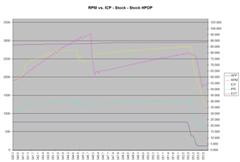 Adrenaline and Overdrive (click to enlarge...)
Adrenaline and Overdrive (click to enlarge...)
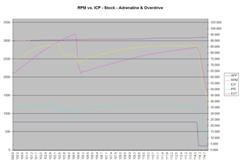
As we move on to the Level 1 program, we again see results that are very similar to the Stock program. The drop in IPR is readily noticeable with only minor differences elsewhere. EOT is again higher, but only by a few degrees which is consistent with our observations.
Evolution Level 1 (60 HP)
Stock HPOP (click to enlarge...)
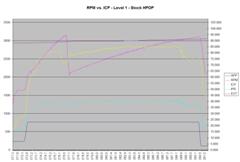 Adrenaline and Overdrive (click to enlarge...)
Adrenaline and Overdrive (click to enlarge...)
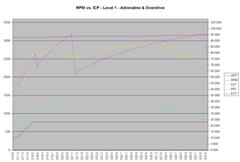
Level 2 is where we really start to see things happening. You can clearly see that the stock pump is now no longer capable of providing the oil volume that is being demanded by the injection system. In struggling to maintain even 2200 PSI, the IPR is steadily climbing at a rate of 3% per second. This is where most people feel the lack of power at full throttle and is actually what I felt under these conditions. A P1211 code was observed during this run, consistent with the lack of ICP.
In looking at the A&O graph, it is readily apparent that not only is there no problem maintaining 3100 PSI (actually overshooting a little at the start of the curve) but the IPR curve is less than 40%. There is no question here that the A&O setup is working effectively. Mid to upper RPM acceleration was consistent and strong with no noticable flat spots at all during the run.
Evolution Level 2 (80 HP)
Stock HPOP (click to enlarge...)
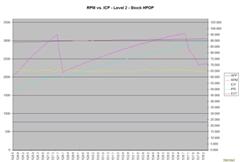 Adrenaline and Overdrive (click to enlarge...)
Adrenaline and Overdrive (click to enlarge...)
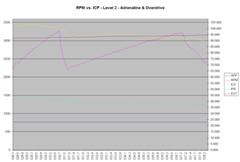
So now we arrive at level 3. Just like with Level 2, the stock pump is not able to meet the volume demands, dropping to 2000 PSI for much of the run and the IPR curve rising 3% per second trying to keep up. The somewhat "flat" feeling at full throttle was consistent with the corresponding drop in ICP and a P1211 was also observed during this run.
With the A&O setup, the curve was again much like the Level 2 program. Acceleration was consistent throughout the run with the curve showing the ICP fully stable and the IPR curve settling in at about 40%. This felt about as strong as any otherwise stock injector truck could feel, although again, these are merely objective observations.
Evolution Level 3 (100 HP)
Stock HPOP (click to enlarge...)
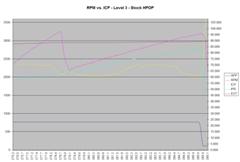 Adrenaline and Overdrive (click to enlarge...)
Adrenaline and Overdrive (click to enlarge...)
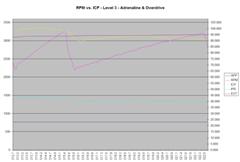
The next graph is a 4th gear, full throttle run in Level 3 from 75 MPH to 95 MPH which lasted about 14 seconds. The ICP curve is about as flat as you could possibly ask for with the IPR at about 41% for the entire run. I don't have a stock run of this, for which I apologize.
Evolution Level 3 (100 HP), 4th Gear, 75 MPH to 95 MPH
Adrenaline and Overdrive (click to enlarge...)
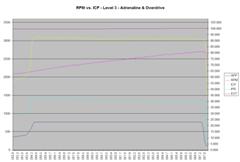
I know these graphs are just a small snapshot of the data we recorded, but I feel that it is a fair representation of the all the data we collected.
My personal observations have all been positive and I am extremely impressed with results. While there are a number of performance related products available for the 7.3L, very few offer the immediate and unquestionable results that I experienced with the A&O setup. Given the cost of the setup (Overdrive
AND Adrenaline), it's less expensive then most twin pump setups and will provide more than enough oil to feed even the thirstiest of injectors. If you take the Adrenaline out of the equation and just run the stock HPOP, then it becomes an even better proposition as it cuts the costs dramatically and still performs well. There is no question in my mind that the A&O setup worked as expected (or even better) and even though it far exceeds the oil demands of the average truck, it worked very well with no modifications at all to the tuning. Here are some of the improvements I have noticed resulting from simply installing the pump setup:
- Quicker startups, especially when cold
- Improved throttle response (breaks the tires loose every time I stab the throttle)
- Slightly improved fuel economy (.6 to .8 MPG at 75 MPH with no tuning changes)
One of the things I also found quite impressive is that despite the comparatively aggressive nature of the setup in regards to oil volume, I ran into none of the "romping idle" issues that are often observed on dual pump setups. At this time, I can only attribute this to the fact that this setup uses a single HPOP/IPR and the oil flow regulation is more accurately controlled. It may also help that since the pump is spinning faster than stock, the pressure pulses in the oil rails are smaller and narrower. Of course, this is all speculation and will require further investigation. Also, please don't take this to mean that I'm bagging on any of the twin-pump setups. They have worked well for years and there are a large number of high HP trucks that run them without issue. It's just that having tuned for both types of setups, it was an interesting difference.
Up to this point, there were only a couple minor issues that I experienced when running the setup.
The first issue was a minor fluctuation at idle. The idle would slowly roll about 50 RPMs and could be felt in both neutral and in drive. This phenomenon is easily resolved with minor tuning changes and we have already isolated and resolved this issue for future calibrations.
The second issue was regarding management of the ICP curve, particularly under hard acceleration in lower gears. On standard calibrations, the IPR is set up to respond in a certain amount of time to changes in oil demand. As seen in some of the above runs, this adjustment occurs at the rate of about 3% per second. In first or second gear, the acceleration of the engine cause the pump to produce oil faster than the IPR can adjust to release it. What we end up with is an initial overshoot of the desired oil pressure (some runs showing over 3600 PSI) and then a slow drop in pressure as it stabilizes. This is directly related to the fact that the pump was spinning 66% faster than stock or 42% faster than the engine. Again, small changes in the tuning easily rectify this situation and prevent the problem of overshooting the desired ICP.
The third issue was a minor increase in EOT during hard acceleration, particularly on runs done in quick succession. Part of the increase, I'm sure, is in direct relation to the fact that we are generating 25% to 30% higher ICP versus the stock HPOP under high load conditions and this increased pressure is also raising the temperature of the oil. The change was usually 4º to 5º C (8º to 10º F) with a couple runs just tipping over 100º C (212º F). Since the main fuel and SOI offsets consider anything up to 112º C (236º F) to be normal operating range, I am not at all concerned with these values, especially since at cruise the EOT was relatively identical to temperatures observed with the stock HPOP.
The next tests will be to run the 25% Overdrive with and without the Adrenaline, as well as the Adrenaline by itself. This should prove to be quite interesting and I think the results will be on par with what we've already seen. I'd also like to get my hands on a 100% Overdrive, but that's probably pushing the limits of what a stock truck can handle.
I think for the price, you simply won't find any better way to improve the volume of the High Pressure Oil System. Even if it were in the same price range as comparable systems that are already available, the flexibility and features would still make it well worth the money.

Until next time, enjoy!